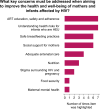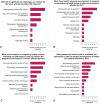Understanding the Impact of Maternal HIV Infection on the Health and Well-Being of Mothers and Infants in South Africa: Siyakhula Collaborative Workshop Report
- PMID: 34335029
- PMCID: PMC8319554
- DOI: 10.2147/JMDH.S317829
Understanding the Impact of Maternal HIV Infection on the Health and Well-Being of Mothers and Infants in South Africa: Siyakhula Collaborative Workshop Report
Abstract
The Siyakhula study is an ongoing, observational cohort study in Pretoria, South Africa, that aims to understand how maternal HIV infection and perinatal environmental factors shape development and health in infants who are HIV-exposed (in utero and during breastfeeding) but remain uninfected themselves (HEU). The Siyakhula Collaborative Workshop, which took place at the Research Centre for Maternal, Fetal, Newborn & Child Health Care Strategies at Kalafong Hospital in Pretoria, South Africa on November 15-16, 2018, brought together a group of international health scientists, clinicians, and stakeholders, including women with lived experience, to build capacity for research and training on the impact of HIV infection on women's and infants' health across geographical and disciplinary boundaries. The workshop sought to summarise the state of knowledge on the effects of being HEU on infant development and health in the first two years of life, identify gaps in existing research on modifiable exposures that may be associated with poor infant development, and develop ideas for novel research and interventions to lessen or prevent adverse health outcomes in pregnant or breastfeeding people living with HIV. These proceedings summarise the pre-workshop consensus process that was used to identify priority areas to discuss during small-group breakout sessions, as well as the themes and key challenges that emerged from these discussions during the workshop.
Keywords: HIV; PMTCT; breastfeeding; growth; immune; neurodevelopment.
© 2021 White et al.
Conflict of interest statement
Prof. Dr. Theresa Rossouw report Speaker fees received from Merck - not related to the work presented in this publication. The authors reports no other conflicts of interest in this work.
Figures






References
-
- UNAIDS. Fact Sheet - World AIDS Day. Global HIV statistics; 2020.
-
- UNAIDS, AIDSinfo. Elimination of mother-to-child transmission: HIV-exposed children who are uninfected. Available from: https://aidsinfo.unaids.org/. Accessed July12, 2021.
LinkOut - more resources
Full Text Sources

